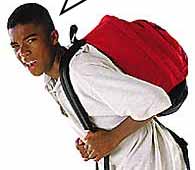

The Association of Backpack Use
and Back Pain in AdolescentsThis section is compiled by Frank M. Painter, D.C.
Send all comments or additions to: Frankp@chiro.org




FROM: Spine (Phila Pa 1976) 2003 (May 1); 28 (9): 922–930
Sheir-Neiss GI1, Kruse RW, Rahman T, Jacobson LP, Pelli JA
Department of Research,
Alfred I. duPont Hospital for Children,
Wilmington, Delaware 19899, USA.
Study Design: A cross-sectional study comprising the first phase of an ongoing, longitudinal prospective study was conducted.
Objective: To investigate the relation between backpack use and back pain in adolescents.
Summary of Background Data: The prevalence of nonspecific back pain increases dramatically during adolescence from less than 10% in the pre-teen-age years up to 50% in 15- to 16-year-olds. There is widespread concern that heavy backpacks carried by adolescents contribute to the development of back pain.
Methods: A total of 1126 children, ages 12 to 18 years, participated by completing a questionnaire about their health, activities, and backpack use. Each child's body weight, height, and backpack weight were measured. A child was classified as having back pain if one or more of the following were reported during the preceding month: neck or back pain that had interfered with school or leisure, neck or back pain with a severity rating of 2 or more on a scale of 0 to 10, a visit to a physician or therapist for neck or back pain, or exemption from physical education or sports because of neck or back pain.
Results: Of 1122 backpack users, 74.4% were classified as having back pain, validated by significantly poorer general health, more limited physical functioning, and more bodily pain. As compared with no or low use of backpacks at school, heavy use (odds ratio, 1.98; P < 0.0001) was independently associated with back pain. Female gender and larger body mass index also were significantly associated with back pain. As compared with adolescents who had no back pain, adolescents with back pain carried significantly heavier backpacks that represented a significantly greater percentage of their body weights.
Conclusion: The use of backpacks during the school day and backpack weights are independently associated with back pain.

Return to BACKPACKS
Since 5-12-2003


| Home Page | Visit Our Sponsors | Become a Sponsor |
Please read our DISCLAIMER |
